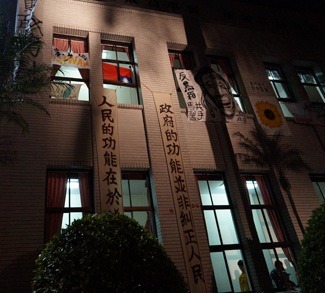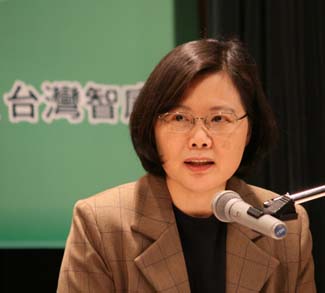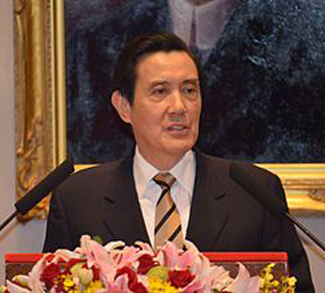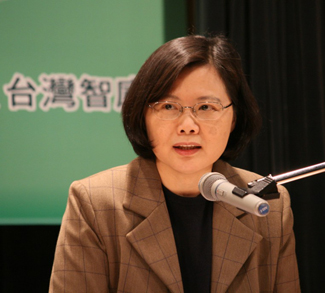It’s a headline that shocks: Students occupy the national legislature, issue an ultimatum to the ruling government. And for a little while the local Taiwanese media ran with this sense of shock, portraying the occupying students as a motley and misguided crew of beer-swigging firebrands. But it’s clear to anyone present that this initial act of civil disobedience has blossomed into a wider political movement, complete with its very own sentimental branding.
This is Taiwan’s Sunflower Revolution – at least that’s what the protesters will tell you.
It all began in the early hours of March 18, when roughly 250 students stormed the Legislative Yuan in central Taipei. They were quickly joined by 1,000 other students, and since then the number of supporters surrounding the building has grown to over ten thousand, with many staying through the night despite unseasonably cold weather and bouts of torrential rain.
The demands of the main student group in the legislature are simple. They want Taiwan to pull out of a cross-strait service pact that was signed in July of last year; the establishment of an oversight mechanism to monitor future cross-strait negotiations; and for President Ma Ying-jeou to personally respond to their demands.
The free trade pact in question would reduce trade barriers between China and Taiwan in a variety of service sectors, including culturally sensitive ones such as publishing and media.
Delve into the wider protest movement, however, and the demands get more nuanced. Many students are deeply cynical towards Taiwan’s traditional political parties, owing in part to failed mobilizations in the past – most recently on the issue of nuclear power – and in part due to the cross-strait service pact’s slipshod lifecycle: signed in secret, shelved for eight months, and ultimately bypassed for article-by-article review due to politicking by the opposition Democratic Progressive Party (DPP) and creative interpretation of parliamentary convention by the ruling Nationalist Party (KMT).
Indeed the storming came the night after KMT lawmaker Chang Ching-Chung announced the premature end of an inter-party review of the service pact from some distant corner of the legislature floor – he couldn’t make it up to the podium because it was being physically blocked off by a posse of DPP lawmakers.
This kind of political theatre has had the effect of pushing the younger generation out of the mainstream, and the sunflower movement has consequently been quick to disassociate itself from any affiliation with the opposition DPP. Many of the protesters believe that both of Taiwan’s major parties are more concerned with getting themselves elected than carefully deliberating what is best for the future of their homeland.
Thus the question becomes: what do the protesters believe is best for Taiwan? While there is no shortage of signs pertaining to Taiwan’s political destiny (“Don’t let Taiwan become the next Hong Kong!” read one), the protests have an overarching economic element that might surprise those inclined to view Taiwanese politics through the exclusive lens of cross-strait relations. I asked a professor from Hualien what these protests were about and his immediate response was simply “globalization.” Later, one of the students on the microphone compared the sense of community surrounding his father’s tiny shop in Nantou County with the faceless onslaught of Costco and other large retailers. These concerns echo the current economic reality faced by Taiwanese youths entering the workforce, that of stagnant wages and a rising cost of living.
Walking around the protest site on Saturday, it was hard not to be struck by the high level of organization on display. A legion of student volunteers worked tirelessly to direct pedestrian traffic, distribute food, drinks, and blankets, and minimize the protest’s impact on local residents and businesses. Doctors and nurses had also volunteered to remain on-site, and there was a list of lawyers on standby should protesters require any legal assistance. The atmosphere was laid-back and jovial, with people of all ages coming to see the protest site and lend their support. Even the odd policeman standing guard at the sidelines was willing to crack a smile for a photo.
Sunday was a different story entirely. Students broke through a police barrier and flooded into the nearby Executive Yuan building (the government’s cabinet offices) early in the evening, creating a more chaotic atmosphere as volunteers struggled to cope with new developments. Unlike with the original occupation site, the executive branch of government has the authority to order a police intervention at the Executive Yuan, which is exactly what they did. Riot police amassed leading up to midnight when the order finally came to move in. Seated students were dragged one-by-one from the building, and in some cases were brutally attacked with batons and water cannons. It took until after dawn for the site to be completely cleared, resulting in 58 arrests and over 150 injuries.
As of Tuesday afternoon the occupation of the Legislative Yuan is still ongoing, and Taiwanese people from all wakes of life are still digesting the shocking pictures and video from the police action on Sunday. It appears the protests are still gaining momentum, with thousands sleeping on the streets through Monday night and a large vigil being held outside the Executive Yuan at dawn. There are also scattered calls for a strike from various universities, and a crowd-funding initiative has been launched to purchase advertising space in the New York Times and Apple Daily (a popular Hong Kong newspaper).
It appears that the students aren’t going anywhere, precluding any quick return to work for the spitting, brawling, hair-pulling, and shoe-throwing “adults” who claim to represent them. And given that President Ma (who currently enjoys a 10% approval rating) is politically “all in” on bringing Taiwan into China’s economic orbit, it’s unlikely that he will acquiesce to their demands unless new circumstances force his hand.




